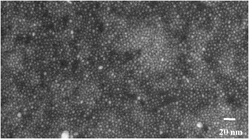No CrossRef data available.
Article contents
Metalized carbon nanotubes as a conductive material for energy storage devices
Published online by Cambridge University Press: 15 July 2016
Abstract

Herein is described the preparation and characterization of conductive materials for application in energy storage devices, such as fuel cells. The synthetic approach uses commercially available materials and simple experimental procedures to decorate multi-walled carbon nanotubes (MWCNTs) with plain and thiolated gold nanoparticles (Au NPs). The compositional characterization data (x-ray photoelectron spectroscopy) and the electrical conductivity data (cyclic voltammetry (CV) and oxygen reduction reaction (ORR)) for the MWCNT-Au NP composites, both pre- and post-anneal, is reported.
Keywords
- Type
- Articles
- Information
- Copyright
- Copyright © Materials Research Society 2016



